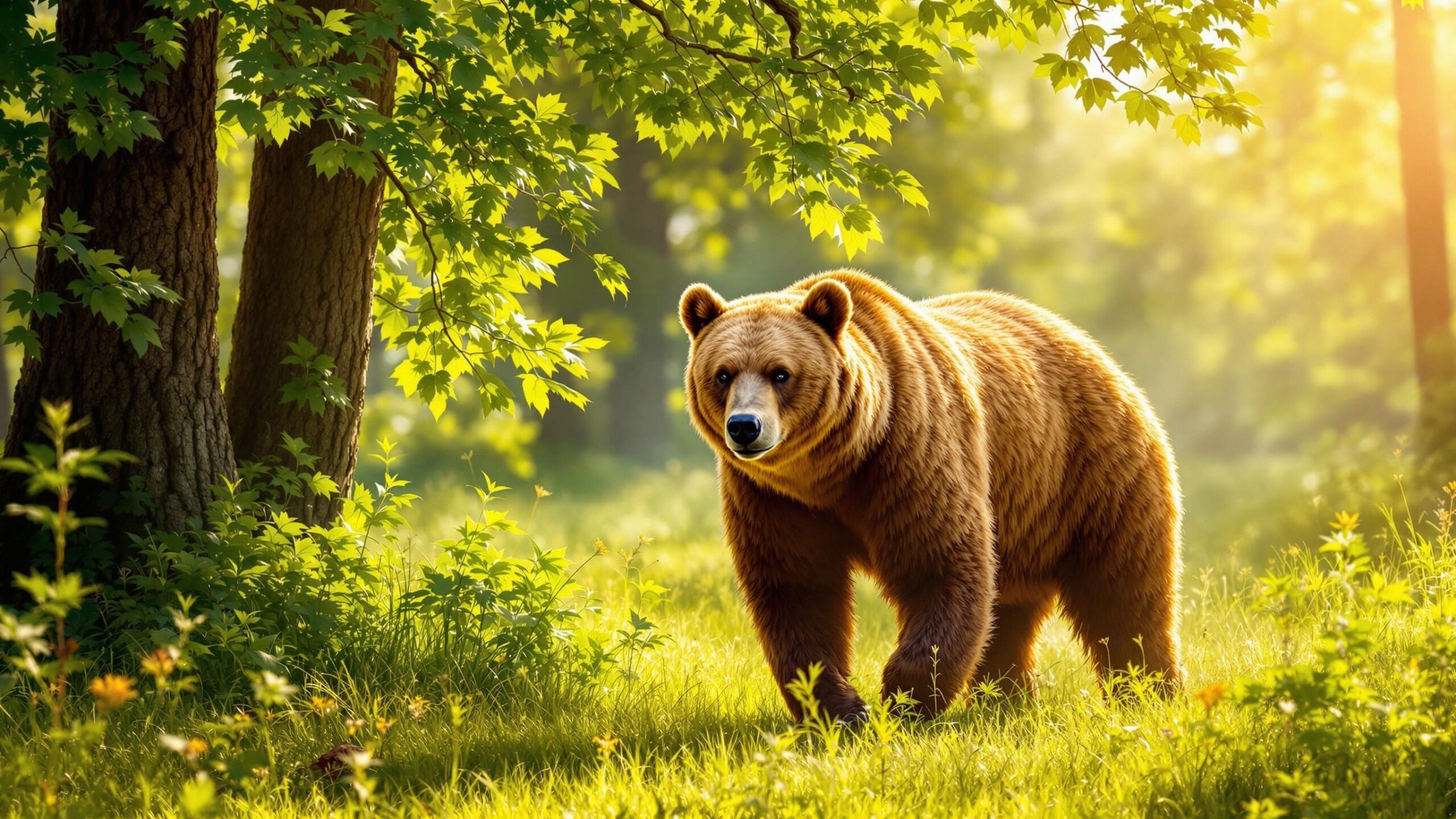Brown Bears: The Mighty Titans of the Wilderness
There are few animals on Earth that stir the imagination quite like the brown bear. Towering, powerful, and yet often surprisingly gentle, brown bears command both fear and fascination. From the fish-rich rivers of Alaska to the misty mountains of Europe and the icy stretches of Russia, these massive mammals have roamed the wilds for thousands of years. Brown bears are more than just apex predators or iconic wilderness dwellers—they are keystone species, vital parts of the ecosystems they inhabit. They are symbols of strength and endurance, and their story is one of resilience in the face of environmental change, human conflict, and mythic legacy. This page dives deep into the world of brown bears, exploring the biology, diversity, and cultural significance of one of nature’s most awe-inspiring creatures.
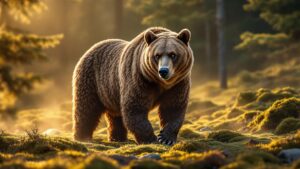
Eurasian Brown Bear
Eurasian Brown Bear: The Icon of Europe’s Wild Heart The Eurasian brown bear (Ursus arctos arctos), a subspecies of the widely distributed brown bear, stands as one of the most iconic and awe-inspiring creatures of the European wilderness. Towering in stature yet elusive in behavior, this majestic mammal has long held a revered place in folklore, ecology, and modern conservation discussions. Found across a vast range from Western Europe to
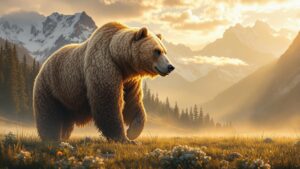
Grizzly Bear
Grizzly Bear (Ursus arctos horribilis): The Mighty Monarch of the Wild The grizzly bear, scientifically known as Ursus arctos horribilis, stands as one of North America’s most iconic and formidable wild animals. Revered for its immense strength, intelligence, and tenacity, the grizzly commands attention whether roaming remote alpine meadows or salmon-rich riverbanks. As a subspecies of the brown bear (Ursus arctos), the grizzly is distinguished by its inland range and
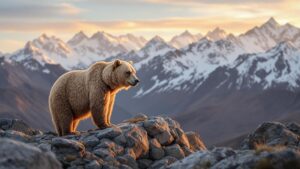
Himalayan Brown Bear
Himalayan Brown Bear (Ursus arctos isabellinus): A High-Altitude Giant of the Wild Amidst the jagged peaks and frigid winds of the Himalayas, one of the world’s most elusive and majestic mammals treads softly across snowfields and alpine meadows—the Himalayan Brown Bear. Scientifically known as Ursus arctos isabellinus, this subspecies of the Brown Bear is a symbol of rugged wilderness, powerful survival, and delicate ecological balance in the high-altitude realms of

Kodiak Bear
Kodiak Bear (Ursus arctos middendorffi): The Island Giant of North America Among the world’s most awe-inspiring creatures, few evoke a sense of raw power and majesty quite like the Kodiak bear. Scientifically named Ursus arctos middendorffi, this subspecies of the brown bear is a titan of the animal kingdom. Found only on the remote islands of Alaska’s Kodiak Archipelago, the Kodiak bear is among the largest terrestrial carnivores alive today—rivaled
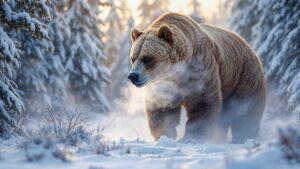
Siberian Brown Bear
Siberian Brown Bear (Ursus arctos collaris): The Silent Guardian of the Russian Wilderness Deep within the boundless forests of Siberia roams one of the largest and most enigmatic predators on Earth—the Siberian brown bear, scientifically known as Ursus arctos collaris. A subspecies of the widespread Eurasian brown bear, this majestic creature embodies both the mystery and power of the Russian wilderness. From the frostbitten Ural Mountains to the vast taiga

Tibetan Blue Bear
Tibetan Blue Bear (Ursus arctos pruinosus): The Elusive Ghost of the Himalayas High on the wind-swept plateaus and mist-veiled slopes of the Tibetan Plateau roams a creature so rare and mysterious that even seasoned wildlife researchers rarely glimpse it—the Tibetan Blue Bear. Known scientifically as Ursus arctos pruinosus, this remarkable animal is one of the most enigmatic and least understood subspecies of the Brown Bear. Clad in an unusual silvery-blue
Understanding the Brown Bear: Biology, Behavior, and Breadth
Brown bears belong to the species Ursus arctos, one of the most widely distributed bear species in the world. Despite being classified as carnivores, they are omnivorous and opportunistic feeders, with diets that include berries, roots, insects, fish, carrion, and even large mammals when available. Their massive shoulder hump—made of powerful muscle—enables them to dig with great strength, while their long claws and strong jaws serve as tools for both foraging and defense.
Brown bears exhibit great variation in size depending on their region and food availability. Coastal bears like those in Alaska often reach enormous sizes due to abundant salmon runs, while interior populations may be smaller and more dependent on plant-based diets. Despite their bulk, brown bears are fast runners, strong swimmers, and competent climbers. They hibernate for several months during winter, using their fat reserves to survive the cold while their heart rate and metabolism slow dramatically.
Reproductive behavior is also a marvel of adaptation. Brown bears experience delayed implantation, meaning that even after mating in early summer, the fertilized egg doesn’t implant in the uterus until the fall—only if the mother has gained enough weight. Cubs are born in the den during hibernation, and mother bears emerge in spring with their young, ready to teach them how to survive the harsh, competitive wild.
The Grizzly Bear: The Icon of North America’s Wilderness
In the continental United States and Canada, the most well-known subspecies of the brown bear is the grizzly bear. The term “grizzly” originates from their grizzled, or silver-tipped, fur, though it’s also an apt descriptor of their awe-inspiring presence. Grizzly bears (Ursus arctos horribilis) are primarily found in Alaska, western Canada, and parts of the northwestern United States, including Montana and Wyoming.
Grizzlies have become symbols of untamed wilderness and the struggle between human expansion and natural preservation. In Yellowstone National Park, for example, grizzlies are a conservation success story. After facing near-extinction in the lower 48 states, they now number over 700 in the Greater Yellowstone Ecosystem. They are often seen feasting on cutthroat trout, digging for roots, or even hunting elk calves in spring. These bears play a vital ecological role. By digging and turning over soil, they help aerate the forest floor. Their scat spreads seeds across vast distances. When they feed on salmon or ungulates, the nutrient-rich remains fertilize the land. Despite their solitary nature, grizzlies profoundly impact the environments they traverse, and their health is often seen as a reflection of the health of the wilderness itself.
The Kodiak Bear: The Colossus of the Coast
Among all brown bears, the Kodiak bear (Ursus arctos middendorffi) holds the title of the largest. Native to the Kodiak Archipelago in Alaska, these bears can reach weights of over 1,500 pounds and stand over 10 feet tall when upright. Despite their massive size, Kodiak bears are not particularly aggressive unless provoked, and they tend to live in low-density populations with minimal territorial conflict.
What makes Kodiak bears particularly fascinating is their isolation. Having been separated from mainland brown bears for over 10,000 years, they have developed a unique genetic profile. The abundant salmon runs and rich plant life on the islands support their incredible bulk. Watching a Kodiak bear stand motionless in a river, waiting to strike a leaping fish with surgical precision, is a confirmation to their patience, skill, and deep integration into their environment. The Kodiak bear has also played an important role in indigenous Alutiiq culture, where it is seen as both a spiritual entity and a provider of food and materials. Respect for the bear’s power and presence is deeply woven into the cultural traditions of the people who have lived alongside them for millennia.
The Eurasian Brown Bear: Europe’s Shy Giant
Across Europe and parts of Asia, the Eurasian brown bear (Ursus arctos arctos) quietly roams forests, mountains, and tundras. Once widespread across the continent, their populations have been reduced by habitat loss, hunting, and human development. Yet, they remain resilient. From the Carpathian Mountains of Romania to the wilderness of Scandinavia, brown bears are making a slow but steady comeback. These bears tend to be more elusive than their North American cousins. In densely populated areas, they have adapted to avoid human contact, often becoming nocturnal and sticking to remote terrain. Still, they play crucial ecological roles by controlling populations of prey animals, scavenging carcasses, and fertilizing forest floors. In countries like Finland, Slovenia, and Croatia, bear watching has become a major ecotourism attraction. These programs not only help fund conservation efforts but also promote coexistence by showing that bears are not the mindless beasts of fairy tales, but intelligent and purposeful beings.
The Siberian Brown Bear: The Ghost of the Taiga
Russia is home to the largest population of brown bears in the world, and among its most iconic subspecies is the Siberian brown bear. These bears inhabit the remote forests and mountains of eastern Russia and are often cloaked in mystery due to the inaccessibility of their territory.
Siberian brown bears are robust and well-adapted to the harsh climate. With thick fur and considerable fat reserves, they survive brutal winters in some of the coldest environments on Earth. They feed on berries, fish, roots, and occasionally prey on hoofed animals like moose or reindeer. In regions like Kamchatka, brown bears and humans have shared a tenuous relationship—sometimes harmonious, sometimes tragic. One of the more fascinating aspects of Siberian brown bears is their role in mythology and folklore. In ancient Russian legends, the bear is often revered as a wise forest guardian, a mediator between worlds, and a symbol of introspection. Even today, the bear is Russia’s national symbol, representing strength, resilience, and connection to nature.
The Himalayan Brown Bear: The Elusive Ghost of the Mountains
In the high altitudes of northern Pakistan, India, and Nepal, the Himalayan brown bear exists as one of the rarest and most endangered subspecies of Ursus arctos. With a golden-brown coat and a shy demeanor, this bear is seldom seen by humans. It prefers high alpine meadows and remote valleys, where it feeds on herbs, roots, and small animals. Conservationists face immense challenges in protecting the Himalayan brown bear. Habitat fragmentation, livestock conflicts, and lack of awareness have driven it to the brink of extinction in many areas. There are fewer than 1,000 believed to be left in the wild. And yet, in recent years, increased awareness and the involvement of local communities have sparked hope for its recovery.
The Himalayan brown bear also holds a place in cryptozoology and folklore, often cited in local myths about the yeti or “abominable snowman.” These tales reflect both the mystery of the landscape and the aura of the bear itself—a creature both real and mythical, vanishing into the snow just as you catch a glimpse.
Brown Bears and the Environment: Guardians of the Wild
Brown bears do more than simply survive in their ecosystems—they actively shape them. Their digging helps churn soil and create seedbeds for new plant growth. Their feeding habits regulate the populations of prey species and contribute to the natural cycling of nutrients. In salmon-rich ecosystems, bears consume the fatty fish and leave the remains scattered across the forest, feeding countless scavengers and enriching the soil with marine nutrients. The loss of brown bears in any ecosystem leads to a cascade of changes. Without their balancing presence, prey populations can spike, vegetation can become overgrazed, and other scavengers may struggle to find food. Brown bears are true keystone species—their influence runs deep.
The Challenge of Coexistence: Humans and Brown Bears
Wherever brown bears live, their story is intertwined with that of humans. They have been hunted, feared, revered, and romanticized. They’ve been worshipped as gods and villainized as monsters. In modern times, the greatest threat to brown bears is habitat loss and human encroachment. Yet, there is reason for hope. Conservation programs around the world have helped stabilize or increase bear populations. National parks, protected zones, and wildlife corridors allow bears to move, feed, and reproduce with less interference. Education programs have taught communities how to manage trash, protect livestock, and safely coexist with bears. Technology such as wildlife cameras and GPS collars has improved our understanding of bear behavior, enabling better conservation strategies. There are still challenges. Poaching, road development, and climate change continue to put pressure on brown bears. But they are adaptable, intelligent survivors. If we continue to give them space, protection, and respect, they can—and will—thrive.
Why Brown Bears Still Captivate Us
Brown bears live on the edge of myth and reality. They remind us of a wilder world, one not governed by the hum of cities but by the call of rivers and the rhythm of the seasons. Watching a bear in the wild is a transformative experience. It humbles and inspires. It makes you feel small—and more deeply connected to something vast and ancient. Each subspecies of brown bear, from the Kodiak colossus to the Himalayan ghost, tells its own story. Together, they paint a portrait of resilience, diversity, and balance. Brown bears are not just powerful animals; they are vital symbols of what we risk losing and what we still have time to protect. This article is just the beginning of your journey into the world of brown bears. Each subspecies, each ecosystem, each bear behavior is its own gateway into discovery. Whether you’re a student, a traveler, a conservationist, or simply a lover of wild things, let the story of the brown bear ignite your curiosity and compassion. These mighty creatures are calling—from the forest shadows, the coastal cliffs, and the mountain winds. Will you listen?

